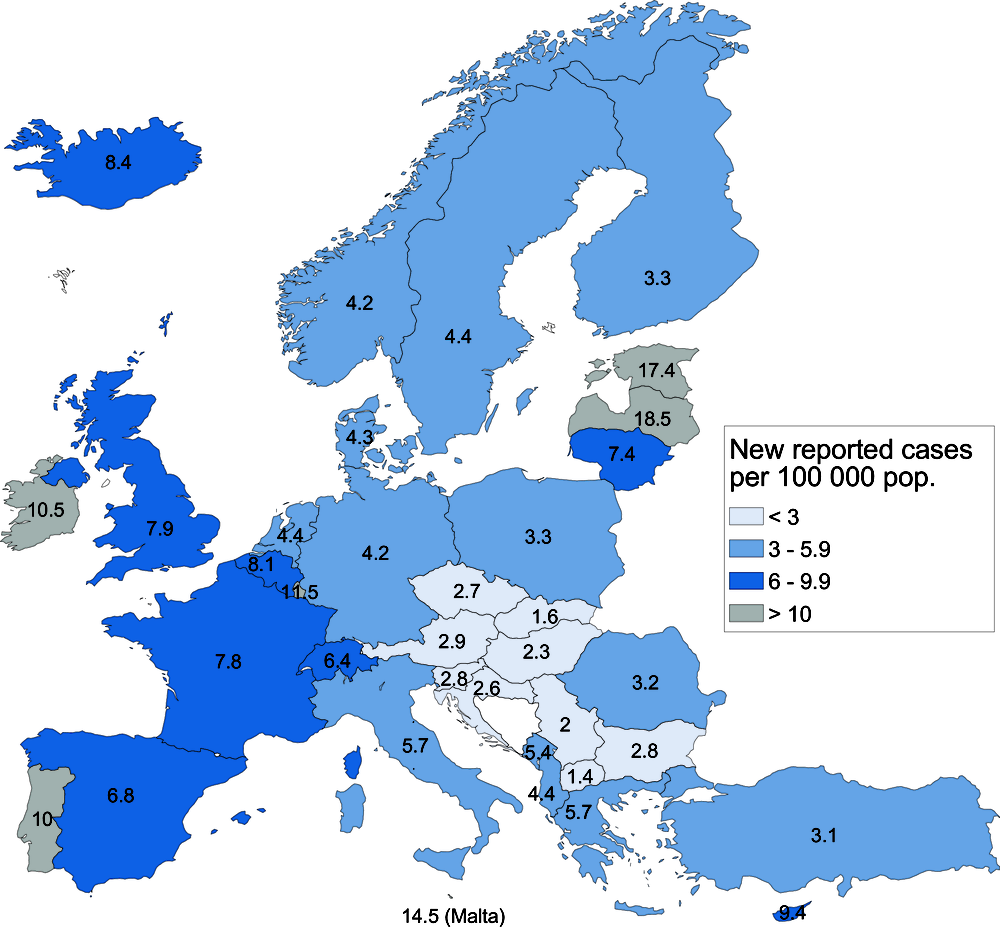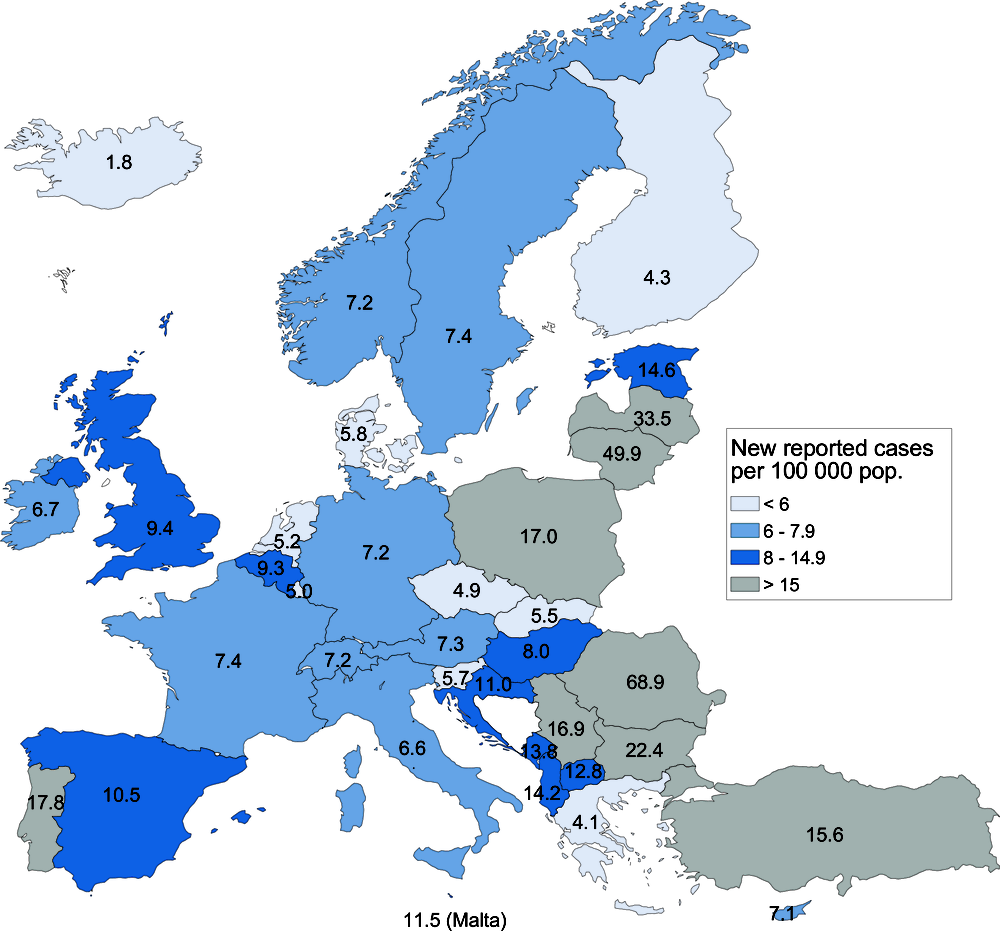New reported cases of hiv and tuberculosis
HIV remains a major public health issue in Europe, with more than 610 000 diagnosed people living with HIV infection in EU countries in 2016 (ECDC/WHO Regional Office for Europe, 2017). In addition, another estimated 200 000 people are undiagnosed and unaware that they are living with HIV infection (Pharris et al., 2016). Nearly 30 000 people across EU countries were newly diagnosed with HIV in 2016. This equals about six new cases of HIV infection per 100 000 population on average. Latvia had the highest rate of new cases (18.5 per 100 000 population), followed by Estonia and Malta. The lowest rates were in the Slovak Republic and Hungary, with rates lower than 2.5 new cases per 100 000 population (Figure 3.26).
The number and rate of newly diagnosed HIV cases have declined slightly overall over the past decade. However, the trend has evolved differently across countries. In Estonia and Portugal, infection rates have decreased rapidly, although the infection rates remain above the EU average. In Latvia and Malta, infection rates have increased at least slightly since 2007 (ECDC/WHO Regional Office for Europe, 2017).
Men are about three times more likely to be diagnosed with HIV than women. About 40% of new HIV transmission is through men having sex with men and 32% by heterosexual contact, while 4% of new cases are through drug injection. Nearly 30% of new cases in 2016 were diagnosed at an advanced stage of HIV and almost 50% had already been infected for several years. People who were diagnosed several years after being infected were more likely to be older, infected by heterosexual sex or by drug injection, and to be women.
Sustained efforts are needed to reduce new HIV infections through effective prevention campaigns, and more frequent HIV testing and education campaigns targeting high risk groups (EC, 2018).
Tuberculosis is still an important public health issue in several EU countries, despite notable progress in most countries in reducing the number of cases over the past few years. Nearly 59 000 new cases of tuberculosis were reported across EU countries in 2016, down from about 70 000 cases in 2012. Romania had the highest rate of reported cases of tuberculosis in 2016, with 68.9 per 100 000 population, followed by Lithuania and Latvia, with rates above 30 per 100 000 population (Figure 3.27). Greece, Finland and the Czech Republic had the lowest rates, with rates below 5 per 100 000 population in 2016. Men are much more likely to be infected by tuberculosis than women in all EU countries.
Although the number and rate of tuberculosis cases have decreased in nearly all countries since 2012, the pace of decline has varied by country. In Romania, the rate has decreased by more than 20% since 2012. The rates also declined sharply in Lithuania and Latvia. However, the rates have increased in Germany (from 5.2 to 7.2 per 100 000 population) and Sweden (6.6 to 7.4 per 100 000 population) between 2012 and 2016.
Among people with tuberculosis for whom information was available on HIV, about 4.5% were co‐infected by HIV.
Antimicrobial resistance to tuberculosis threatens effective treatment and control. On average, about 4% of cases of tuberculosis with drug susceptibility testing were multi-drug resistant. These rates were much higher in Lithuania, Estonia and Latvia than in other countries (ECDC/WHO Regional Office for Europe, 2018).
Despite progress, further efforts are needed to eliminate tuberculosis in EU countries in the coming years. Countries can take a series of actions to reduce tuberculosis infections, including by addressing the needs of vulnerable groups such as migrants, and by optimising the prevention and care of drug-resistant tuberculosis (EC, 2018).
The rates of reported HIV are the number of new cases per 100 000 population at year of diagnosis. Under-reporting and under-diagnosis affect the reported rates, and may represent as much as 40% of cases in some countries (ECDC/WHO Regional Office for Europe, 2017).
A new reported case of tuberculosis is defined as a patient in whom tuberculosis has been confirmed by bacteriology or diagnosed by a clinician. The rates are expressed per 100 000 population (ECDC/WHO Regional Office for Europe, 2018).
References
EC (2018), Commission Staff Working Document on Combatting HIV/AIDS, Viral Hepatitis and Tuberculosis in the European Union and Neighbouring Countries – State of play, policy instruments and good practices, European Commission, Brussels.
ECDC/WHO Regional Office for Europe (2018), Tuberculosis Surveillance and Monitoring in Europe 2018 – 2016 data, Stockholm.
ECDC/WHO Regional Office for Europe (2017), HIV/AIDS Surveillance in Europe 2017 – 2016 data, Stockholm.
Pharris et al. (2016), “Estimating HIV incidence and number of undiagnosed individuals living with HIV in the European Union/European Economic Area, 2015”, Euro Surveillance Journal, Vol. 21, No. 48.


